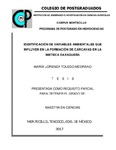Identificación de variables ambientales que influyen en la formación de cárcavas en la mixteca oaxaqueña.
Abstract
La presente investigación busca identificar las variables ambientales que favorecen la formación de cárcavas en la Mixteca Oaxaqueña, a través de un análisis multivariado de los principales factores, que reporta la literatura, que influyen en este tipo de erosión. El presente trabajo inicia con la identificación de las diversas variables que reporta la literatura en la formación de cárcavas y continúa con la recopilación de cartografía en escala superior a 1:50 000. Las variables preseleccionadas fueron sometidas a un análisis estadístico para discriminar aquellas tenían altas correlaciones entre sí, de este proceso resultaron: distancia a fallas, distancia a picos, pendiente, curvatura vertical, curvatura horizontal, índice de posición topográfica, longitud de la pendiente, índice topográfico de humedad, densidad de población e índice de vegetación de diferencias normalizadas (NDVI). Sobre estas variables se aplicó el análisis de componentes principales (ACP) resultando que los primeros seis componentes condensan el 96.7% de la información contenida en las 10 capas analizadas. Con estos seis componentes se realizó la clasificación supervisada y se obtuvieron las zonas con presencia y susceptibilidad a la formación de cárcavas. Para validar las áreas clasificadas con problemas de cárcavas se verificó las áreas con una probabilidad superior al 50% en google earth. La confiabilidad del mapa resultante, en función de ausencia y presencia de cárcavas fue de 96.2%; para un buffer de 50 m resultó del 83.4%, para uno de 100 m fue 81.7% y para uno de 150 m alcanzó el 77.9%. Del trabajo se concluye que las variables de mayor influencia, en la formación de cárcavas son: distancia a fallas, distancias a picos, índice topográfico de humedad, NDVI, pendiente del terreno y densidad de población. _______________ IDENTIFICATION OF ENVIRONMENTAL VARIABLES THAT INFLUENCE THE FORMATION OF GULLIES IN THE MIXTEC OF OAXACA. ABSTRACT: The present research seeks to identify the environmental variables that favor the formation of gullies in the Mixtec of Oaxaca, through a multivariate analysis of the main factors reported in the literature, which influence this type of erosion. . The present work begins with the identification of the various variables reported in the literature on the formation of gullies and it continues with the compilation of cartography on a scale greater than 1:50 000. The pre-selected variables were subjected to a statistical analysis to discriminate those that had high correlations with each other; of this process was obtained: distance to faults, distance to peaks, slope, vertical curvature, horizontal curvature, Topographic Position Index, slope length, Topographic Index of humidity, population density and Normalized Difference Vegetation Index (NDVI). On these variables, the principal component analysis (PCA) was applied, resulting that the first six components condense 96.7% of the information contained in the 10 layers analyzed. With these six components, the supervised classification was made and the areas having or showing susceptibility to gully formation were obtained. In order to validate the areas classified as gully areas, areas with a probability greater than 50% in google earth were verified. The reliability of the resulting map, based on absence and presence of gullies was 96.2%; for a buffer of 50 m it was 83.4%, for one of 100 m it was 81.7% and for one of 150 m it reached 77.9%. From this work, it was concluded that the variables of greater influence in the formation of gullies in the study area, in order of importance, are: distance to faults, distances to peaks, topographic index of humidity, NDVI, land slope and population density.
Collections
- Tesis MC, MT, MP y DC [274]
The following license files are associated with this item:


